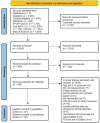Systematic review and meta-analysis of physical activity interventions to increase elementary children's motor competence: a comprehensive school physical activity program perspective
- PMID: 38491432
- PMCID: PMC10943790
- DOI: 10.1186/s12889-024-18145-1
Systematic review and meta-analysis of physical activity interventions to increase elementary children's motor competence: a comprehensive school physical activity program perspective
Abstract
Background: Regular participation in physical activity (PA) benefits children's health and well-being and protects against the development of unhealthy body weight. A key factor in children's PA participation is their motor competence (MC). The comprehensive school physical activity program (CSPAP) framework offers a way to classify existing PA interventions that have included children's MC development and understand the potential avenues for supporting children's MC. However, there have been no systematic reviews or meta-analyses of PA interventions and their effects on the MC of elementary school children (aged 5-12 years) from a CSPAP perspective.
Methods: This study was conducted in accordance with the Preferred Reporting Items for Systematic Review and Meta-Analysis (PRISMA) statement. We searched seven electronic databases (PubMed/Medline, Embase, ERIC, SPORTDiscus, CINAHL, Web of Science, and PsycINFO) for articles on 29 November 2021. The CSPAP framework was used to categorize the different intervention approaches. This review was registered with PROSPERO (CRD42020179866).
Results: Twenty-seven studies were included in the review, and twenty-six studies were included in the meta-analysis. A wide range of PA intervention approaches (e.g., single component or multicomponent) within the context of the CSPAP framework appear to be promising pathways in enhancing children's MC. The results of the aggregate meta-analysis presented that effect sizes for the development of MC from pre-and post- intervention ranged from moderate to large (Hedges' g = 0.41-0.79). The analysis revealed that the predicted moderators, including study length, delivery agent, and study design, did not result in statistically significant moderate variations in MC outcomes. There was, however, considerable heterogeneity in study design, instruments, and study context, and studies were implemented in over 11 countries across diverse settings.
Conclusions: This study uniquely contributes to the literature through its primary focus on the effectiveness of PA interventions on elementary children's MC. This review emphasizes the importance of customizing CSPAP to fit the specific characteristics of each school setting, including its environmental, demographic, and resource attributes. The effectiveness of CSPAP, particularly its physical education (PE) component, is significantly enhanced when these programs are adapted to address the unique needs of each school. This adaptation can be effectively achieved through targeted professional teacher training, ensuring that PE programs are not only contextually relevant but also optimized for maximum impact in diverse educational environments. Researchers and practitioners should pursue how to effectively translate the evidence into practice to better conceptualize CSPAPs designed for children's MC development.
Keywords: Child development; Fundamental motor skills; Physical education; Whole-of-school approach.
© 2024. The Author(s).
Conflict of interest statement
The authors declare no competing interests.
Figures
Similar articles
-
A Systematic Review of Multi-Component Comprehensive School Physical Activity Program (CSPAP) Interventions.Am J Health Promot. 2021 Nov;35(8):1129-1149. doi: 10.1177/08901171211013281. Epub 2021 May 6. Am J Health Promot. 2021. PMID: 33955278
-
School-based interventions for reducing disciplinary school exclusion: a systematic review.Campbell Syst Rev. 2018 Jan 9;14(1):i-216. doi: 10.4073/csr.2018.1. eCollection 2018. Campbell Syst Rev. 2018. PMID: 37131379 Free PMC article.
-
Toward a whole-of-virtual school framework for promoting student physical activity: a scoping review protocol.Syst Rev. 2024 Oct 31;13(1):272. doi: 10.1186/s13643-024-02689-9. Syst Rev. 2024. PMID: 39482791 Free PMC article.
-
Effectiveness of school-based interventions on fundamental movement skills in children: a systematic review and meta-analysis.BMC Public Health. 2025 Apr 24;25(1):1522. doi: 10.1186/s12889-025-22696-2. BMC Public Health. 2025. PMID: 40275209 Free PMC article.
-
Effects of Physical Activity on Children's Motor Skill Development: A Systematic Review of Randomized Controlled Trials.Biomed Res Int. 2020 Dec 30;2020:8160756. doi: 10.1155/2020/8160756. eCollection 2020. Biomed Res Int. 2020. PMID: 33457415 Free PMC article.
Cited by
-
Increasing adolescents' physical activity levels through a comprehensive school-based physical activity program: study protocol of the cluster randomized controlled trial Active School.BMC Pediatr. 2024 Sep 4;24(1):561. doi: 10.1186/s12887-024-05034-0. BMC Pediatr. 2024. PMID: 39232723 Free PMC article.
-
Developing an Inclusive Dance Guide for Children With Cerebral Palsy: A Co-Design Process and Initial Feasibility Study.Health Expect. 2025 Jun;28(3):e70304. doi: 10.1111/hex.70304. Health Expect. 2025. PMID: 40432276 Free PMC article.
-
Multi-Context Strategies and Opportunities for Increasing Levels of Physical Activity in Children and Young People: A Literature Review.Children (Basel). 2024 Nov 30;11(12):1475. doi: 10.3390/children11121475. Children (Basel). 2024. PMID: 39767904 Free PMC article. Review.
-
The impact of a school-based physical activity program on children's movement behaviors, aerobic fitness and motor competence: a follow up study.Front Sports Act Living. 2025 Feb 27;7:1541862. doi: 10.3389/fspor.2025.1541862. eCollection 2025. Front Sports Act Living. 2025. PMID: 40083799 Free PMC article.
-
Reviewing the association between motor competence and physical activity from a behavioral genetic perspective.Front Psychol. 2025 Apr 28;16:1480631. doi: 10.3389/fpsyg.2025.1480631. eCollection 2025. Front Psychol. 2025. PMID: 40357490 Free PMC article.
References
-
- Centers for Disease Control and Prevention. Increasing physical education and physical activity: a framework for schools. 2019. https://www.cdc.gov/healthyschools/physicalactivity/pdf/2019_04_25_PE-PA.... Accessed 15 May 2022.
-
- World Health Organization . Guidelines on physical activity and sedentary behaviour. Geneva, Switzerland: World Health Organization; 2020.
Publication types
MeSH terms
LinkOut - more resources
Full Text Sources
Medical


